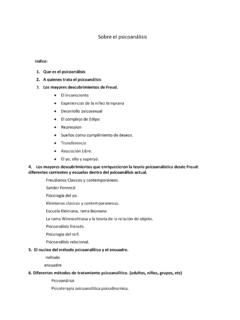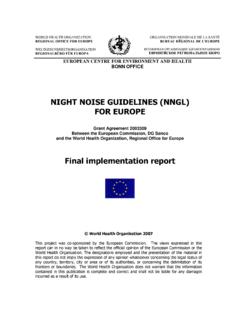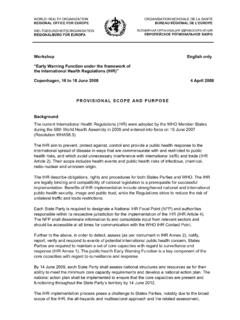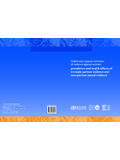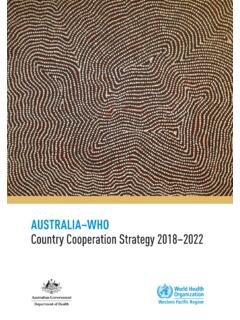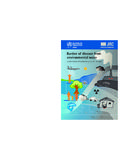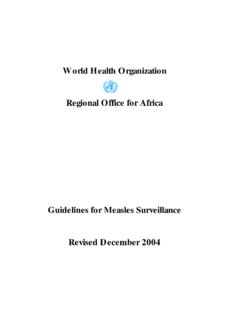Transcription of World Health Organization
1 'II ' .. , , . , . " , - . , .. ,I. , <., . , . ,,, , ., , . I . , .. 'j ..- - " , \.. L , . , J .. World Health Organization WHO Library Cataloguing-in-Publication Data Mental Health action plan 2013-2020. Health . disorders - prevention and control. 3. Mental Health services . ealth planning . Health Organization . ISBN 978 92 4 150602 1 (NLM classification: WM 101). World Health Organization 2013. All rights reserved. Publications of the World Health Organization are available on the WHO web site ( ) or can be purchased from WHO Press, World Health Organization , 20 Avenue Appia, 1211 Geneva 27, Switzerland (teL +41 22791 3264;. fax: +41 22791 4857; e mail: Requests for permission to reproduce or translate WHO publications -whether for sale or for non commercial distribution- should be addressed to WHO Press through the WHO web site { The designations employed and the presentation of the material in this publication do not imply the expression of any opinion whatsoever on the part of the World Health Organization concerning the legal status of any cou ntry, territory, city or area or of its authorities, or concerning the delimitation of its frontiers or boundaries.)}
2 Dotted lines on maps represent approximate border lines for which there may not yet be full agreement . The mention of specific companies or of certain manufacturers' products does not imply that they are endorsed or recom . mended by the World Health Organ ization in preference to others of a sim ilar nature that are not mentioned. Errors and omis . sions excepted, the names of proprietary products are distinguished by initial capital letters. All reasonable precautions have been taken by the World Health Organization 10 verify the information contained in this publica . lion. However, the published material is being distributed without warranty of any kind, either expressed or im plied. The responsibility for the interpretation and use of the maleriallies with the reader. In no event sha ll the World Health Organization be liable for damag es arising from its use.
3 Printed by the WHO Document Production Services, Geneva, Swilzerlond 03. CONTENTS. 1. Foreword 05. 2. Mentat Health Action Plan 2013-2020. Setting the scene 06. Overview of the global situation 07. Structure of the Action Plan 09. Proposed actions for Member States and international and national partners and actions for the 11. Secretariat Appendix 1: Indicators for measuring progress towards defined targets of the comprehensive mental 20. Health action plan 2013-2020. Appendix 2: Options for the implementation of the comprehensive menIal Health action plan 2013-2020 23. 3. Overview of the Mental Health Action Plan 2013-2020 32. Annexes: I. World Health Assembly Resolutions: Resolution of the Sixty-sixth World Health Assembly (May 2013) 34. Comprehensive mental Health action plan 2013- 2020. Resolution of the Sixty-fifth World Health Assembly (May 2012) 34.
4 The global burden of mental disorders and the need for a comprehensive, coordinated response from Health and social sectors at Ihe country level II. Background material: Glossary of main terms 38. links to other global action plans, strategies and programmes 40. lnternalional and regional human rights treaties 43. Selected WHO technical materials and resources on menial Health 44. 05. FOREWORD. Menial welt-being is a fundamental component of WHO's definition of Health . Good menial Health enables people to realize their potential, cope with the normal stresses of life, work productively, and contribute to their communities. Menial Health mailers, but the World has a long way to go to achieve it. Many unfortunate trends must be reversed-neglect of mental Health services and care, and abuses of human rights and discrimination against people with mental disorders and psychosocial disabilities.
5 This comprehensive action plan recognizes the essential role of menial Health in achieving Health for all people. It is based on a life-course approach, aims to achieve equity thr ough universal Health coverage and stresses the importance of prevention . Four major objectives are set forth: more effective leadership and governance for mental Health ; the provision of comprehen- sive. integrated mental Health and social care services in community-based settings; implementation of strategies for promo- tion and prevention; and strengthened information systems, evidence and research . Although the targets of this action plan are ambitious, WHO and its Member Slates are committed to fulfilling them . Dr Margaret Chan Director-General World Health Organization 06 Mental Health Action Plan iiI1-' 2 '. SE IIING THE SCENE. 01 In May 2012, the Sixty-fifth World Health Assembly adopted resol ution on the global burden of menial disorders and the need for a comprehensive, coordinated response from Health and social sectors at the country level.
6 II requested the Director-General, inter alia, to develop a comprehensive mental Health action plan, in consultation with Member States, cover- ing services, pol icies. legislation. plans, strategies and programmes. 02 This comprehensive action plan has been elaborated through consultations with Member States, civil society and interna- tional partners. It lakes a comprehensive and multisectoral approach, through coordinated services from the Health and social sectors, with an emphasis on promotion, prevention, treatment, rehabilitation, care and recovery. It also sets out clear actions for Member States, the Secretariat and international, regional and national level partners, and proposes key indicators and targets that can be used to evaluate levels of implementation, progress and impact. The action plan has, at its core, the globally accepted principle that there is "no Health without mental Health .
7 1. 03 The action plan has close conceptual and strategic links to other global action plans and strategies endorsed by the Health Assembly, including the global strategy to reduce the harmful use of alcohol. the global plan of action for workers' Health , 2008-2017, the action plan for the global strategy for the prevention and control of noncommunicable diseases, 2008-2013, and the global action plan for the prevention and control of noncommunicable diseases (2013-2020]. It also draws on WHO's regional action plans and strategies for mental Health and substance abuse that have been adopted or are being developed. The action plan has been designed to create synergy with other relevant programmes of organizations in the United Nations system, United Nations interagency groups and intergovernmental organizations. 04 The action plan builds upon, but does not duplicate, the work of WHO's mental Health gap action programme [mhGAPj.)
8 The focus of the latter was to expand services for mental Health in low resource settings. The action plan is global in its scope and is designed to provide guidance for national action plans. It addresses, for all resource settings, the response of social and other relevant sectors, as well as promotion and prevention strategies. OS ln this action plan, the term "mental disorders is used to denote a range of mental and behavioural disorders that fall within the International Statistical Classification of Diseases and Related Health Problems, Tenth revision lICD-10]. These include disorders that cause a high burden of disease such as depression, bipolar affective disorder, schizophrenia, anxiety disorders, dementia, substance use disorders, intellectual disabilities, and developmental and behavioural disorders with onset usually occurring in childhood and adolescence, including autism.
9 For dementia and substance use disorders, additional prevention strategies may also be required [as described, for example, in a WHO report on dementia issued in early 2012 2 and in the global strategy to reduce the harmful use of alcohol). Furthermore, the plan covers suicide prevention and many of the actions are also relevant to conditions such as epilepsy. The term "vulnerable groups is used in the action plan to refer to individuals or groups of individuals who are made vulnerable by the situations and environments that they are exposed to (as opposed to any inherent weakness or lack of capacity]. The term "vulnerable groups" should be applied within countries as appropriate to the national situation. 06 The action plan also covers mental Health , which is conceptualized as a state of well-being in which the individual realizes his or her own abilities, can cope with the normal stresses of life, can work productively and fruitfully, and is able to make a contribution to his or her community.
10 With respect to children, an emphasis is placed on the developmental aspects, for instance, having a positive sense of identity, the ability to manage thoughts, emotions, as well as to build social relationships, and the aptitude to learn and to acquire an education, ultimately enabling their full active participation in society. , Annex 1/ proVideS a glossary of mom terms. Imks to other glOOoI oc/ion pions. strategies and programmes, mtemo/ionol and reglOnol human fights treaties. and selected WHO techmcol molenals and resources on mental Health 1 Alzheimer's Dlseose IntemotlOnal DementlO a publIC Health problem Genevo. World Health OrgonlZaliOn. 2012. Mental Health Action Plan 2DI J 20n 07. 07 In the light of widespread human rights violations and discrimination experienced by people with mental disorders, a human rights perspective is essentiaL in responding to the global burden of mental disorders.
